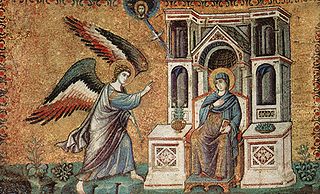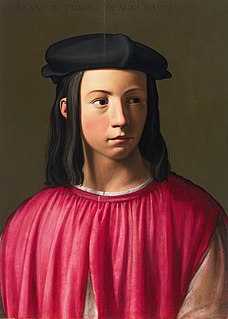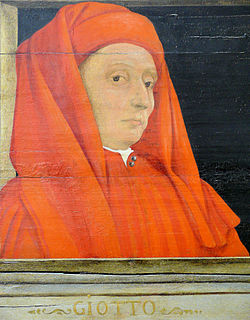
Masaccio, born Tommaso di Ser Giovanni di Simone, was a Florentine artist who is regarded as the first great Italian painter of the Quattrocento period of the Italian Renaissance. According to Vasari, Masaccio was the best painter of his generation because of his skill at imitating nature, recreating lifelike figures and movements as well as a convincing sense of three-dimensionality. He employed nudes and foreshortenings in his figures. This had seldom been done before him.

Simone Martini was an Italian painter born in Siena. He was a major figure in the development of early Italian painting and greatly influenced the development of the International Gothic style.

Lorenzo Monaco was an Italian painter of the late Gothic-early Renaissance age. He was born Piero di Giovanni in Siena. Little is known about his youth, apart from the fact that he was apprenticed in Florence. He was influenced by Giotto and his followers Spinello Aretino and Agnolo Gaddi.

Pietro Cavallini was an Italian painter and mosaic designer working during the late Middle Ages.

Taddeo Gaddi was a medieval Italian painter and architect.

Agnolo Gaddi (c.1350–1396) was an Italian painter. He was born and died in Florence, and was the son of the painter Taddeo Gaddi.

The Basilica di Santa Croce is the principal Franciscan church in Florence, Italy, and a minor basilica of the Roman Catholic Church. It is situated on the Piazza di Santa Croce, about 800 meters south-east of the Duomo. The site, when first chosen, was in marshland outside the city walls. It is the burial place of some of the most illustrious Italians, such as Michelangelo, Galileo, Machiavelli, the poet Foscolo, the philosopher Gentile and the composer Rossini, thus it is known also as the Temple of the Italian Glories.

The Badìa Fiorentina is an abbey and church now home to the Monastic Communities of Jerusalem situated on the Via del Proconsolo in the centre of Florence, Italy. Dante supposedly grew up across the street in what is now called the 'Casa di Dante', rebuilt in 1910 as a museum to Dante. He would have heard the monks singing the Mass and the Offices here in Latin Gregorian chant, as he famously recounts in his Commedia: "Florence, within her ancient walls embraced, Whence nones and terce still ring to all the town, Abode aforetime, peaceful, temperate, chaste." In 1373, Boccaccio delivered his famous lectures on Dante's Divine Comedy in the subsidiary chapel of Santo Stefano, just next to the north entrance of the Badia's church.

Lorenzo di Niccolò or Lorenzo di Niccolò di Martino was an Italian painter who was active in Florence from 1391 to 1412. This early Renaissance artist worked in the Trecento style, and his work maintains influences of the Gothic style, marking a transitional period between the Gothic sensibilities of the Middle Ages while simultaneously beginning to draw on the Classical. Lorenzo's works were usually religious scenes in tempera with gold backgrounds.

Florentine painting or the Florentine School refers to artists in, from, or influenced by the naturalistic style developed in Florence in the 14th century, largely through the efforts of Giotto di Bondone, and in the 15th century the leading school of Western painting. Some of the best known painters of the earlier Florentine School are Fra Angelico, Botticelli, Filippo Lippi, the Ghirlandaio family, Masolino, and Masaccio.

Maso di Banco was an Italian painter of the 14th century, who worked in Florence, Italy. He and Taddeo Gaddi were the most prominent Florentine pupils of Giotto di Bondone, exploring the three-dimensional dramatic realism inaugurated by Giotto.

Italian Renaissance painting is the painting of the period beginning in the late 13th century and flourishing from the early 15th to late 16th centuries, occurring in the Italian Peninsula, which was at that time divided into many political states, some independent but others controlled by external powers. The painters of Renaissance Italy, although often attached to particular courts and with loyalties to particular towns, nonetheless wandered the length and breadth of Italy, often occupying a diplomatic status and disseminating artistic and philosophical ideas.

Niccolò di Pietro Gerini was an Italian painter of the late Gothic period, active mainly in his native Florence although he also carried out commissions in Pisa and Prato. He was not an innovative painter but relied on traditional compositions in which he placed his figures in a stiff and dramatic movement.

The Lives of the Most Excellent Painters, Sculptors, and Architects, often simply known as The Lives, is a series of artist biographies written by 16th-century Italian painter and architect Giorgio Vasari, which is considered "perhaps the most famous, and even today the most-read work of the older literature of art", "some of the Italian Renaissance's most influential writing on art", and "the first important book on art history".
The decade of the 1300s in art involved some significant events.
The decade of the 1360s in art involved some significant events.

Monsignor Giovanni Gaddi or Giovanni di Taddeo di Agnolo Gaddi was an Italian cleric, descending from the noted Gaddi family of bankers and painters. His parents were Taddeo di Agnolo Gaddi and Antonia di Bindo Altoviti. His brother was cardinal Niccolò Gaddi and his nephew cardinal Taddeo Gaddi.

Giotto di Bondone, known mononymously as Giotto and Latinised as Giottus, was an Italian painter and architect from Florence during the Late Middle Ages. He worked during the Gothic/Proto-Renaissance period. Giotto's contemporary, the banker and chronicler Giovanni Villani, wrote that Giotto was "the most sovereign master of painting in his time, who drew all his figures and their postures according to nature" and of his publicly recognized "talent and excellence". Giorgio Vasari described Giotto as making a decisive break with the prevalent Byzantine style and as initiating "the great art of painting as we know it today, introducing the technique of drawing accurately from life, which had been neglected for more than two hundred years".

The Baroncelli Chapel is a chapel located at the end of the right transept in church of Santa Croce, central Florence, Italy.

An anonymous author known as the Anonimo Gaddiano, Anonimo Magliabechiano, or Anonimo Fiorentino is the author of the Codice Magliabechiano or Magliabechiano, a manuscript with 128 pages of text, probably from the 1530s and 1540s, and now in the Central National Library of Florence. It includes brief biographies and notes on the works of Italian artists, mainly those active in Florence during the Middle Ages. Among several other suggestions, the anonymous author has been suggested to be Bernardo Vecchietti (1514–1590), a politician of the court of Cosimo I. The author clearly had intimate access to the Medici court.


















